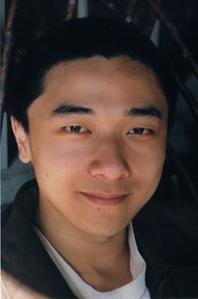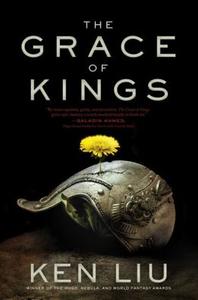
|
|
| photo: Lisa Tang Liu | |
In The Grace of Kings (Saga Press, $27.99), a generation-spanning epic fantasy set on an island world, Kuni Garu is a bandit with a heart of gold who is swept up into the uprising against a decadent, tyrannical emperor. He meets Mata Zyndu, a physical and intellectual giant, and the two become close friends until they must face off against each other for supremacy as leaders of opposing factions.
Ken Liu's fantasy provides a strong sense of culture and place, with airships draped in silks, massive war machines built with ox sinew, and fickle, shapeshifting gods. Liu, who lives in Boston, is a winner of the Nebula, Hugo and World Fantasy awards for his short story "The Paper Menagerie."The Grace of Kings, book 1 of the Dandelion Dynasty series, is his first novel.
What inspired The Grace of Kings?
When I started looking for a novel-length story, my wife reminded me that both of us had grown up steeped in retellings of historical romances, the foundational narratives for the Chinese literary tradition, and I got the idea to recast the broad outlines of such a story in the form of an epic fantasy.
Here's the quick pitch for The Grace of Kings: it's War and Peace with airships; it's the Iliad with smart narwhals and living books; it's Romance of the Three Kingdoms with islands and submarines.
The Grace of Kings reimagines the historical legends around the rise of the Han Dynasty in the third century B.C.E. in a brand new secondary fantasy archipelago world with new cultures, new peoples, and of course, new technology. It melds classical Western epic narrative techniques with tropes taken from Chinese historical romances and wuxia [martial hero] fantasies.
I do mean "classical Western epics"--The Grace of Kings shares much more with older traditions like the Iliad, the Odyssey, the Aeneid and Beowulf than with contemporary epic fantasy, especially in the way characters are depicted in a larger-than-life manner akin to folklore and myth and the way the plot is advanced via a series of "side stories." These features, not coincidentally, are also very much part of the Chinese historical romance tradition.

The "silkpunk" aesthetic that I devised for the novel employs many elements inspired by Chinese and East Asian traditions that I've always wanted to see in fiction: silk-draped airships, soaring battle kites, honor-infused duels that are as much dance as warfare, magical tomes that describe our desires better than we know them ourselves, gods who regret the deeds done in their names, women who plot and fight alongside men, princesses and maids who form lifelong friendships, and sea beasts that bring about tsunamis and storms but also guide soldiers safely to shores.
The silkpunk aesthetic shares with steampunk a fascination with technology roads not taken, but what distinguishes it is a visual style inspired by Chinese block prints and an emphasis on materials of historic significance to East Asia--silk, bamboo, ox sinew, paper, brushes--as well as other organic building materials available to a seafaring culture, like coconut, whalebone, fish scales, corals, etc.
The result is a technology vocabulary that feels more organic and inspired by biomechanics. A good example can be seen in the bamboo-and-silk airships, which compress and expand their gasbags to change the amount of lift, like the swim bladders of fish, and are powered by feathered oars, which means that when illuminated at night, they pulsate and move like jellyfish through an empyrean sea. Similarly, artificial limbs described in the book draw their inspiration from the "wooden ox" of Zhuge Liang in Romance of the Three Kingdoms, which are constructed from intricate wood-based mechanisms powered by ox sinew.
Here are some characters I really liked from the novel's huge cast:
Kuni Garu: He's a rogue: pragmatic, unconventional, romantic, preferring the "interesting" over the "right" or "safe" thing to do.
Mata Zyndu: a scion of old nobility who is the greatest warrior in the land and Kuni's companion/foil.
Gin Mazoti: A street urchin who becomes the greatest tactician of her generation. She starts a revolution that will continue in the rest of the series.
Jia Matiza: An herbalist who falls in love with Kuni. Over the arc of the series, she becomes a power to be reckoned with.
Luan Zya: An engineer who invents machines for both war and peace. He's probably the character I love the most.
And many many more gods, generals, scholars, peasants--all of them with their own stories and their own roles in a revolution that transforms the land.
Perfect summer reading list: what books would you recommend to anyone looking for solid vacation reading?
I don't have a perfect reading list. Every reader is different and what works for me won't necessarily work for you. But here are some books I've enjoyed in the past:
Trading Up by Candace Bushnell. I think this is a wonderful update to the Great American Novel, a kind of Gatsby recast as "chick-lit."
The Lives of Tao by Wesley Chu. An exciting sci-fi action thriller that plays with history in an interesting way. It's the first book in a series that gets better with every book.
Shades of Milk and Honey by Mary Robinette Kowal. Jane Austen with magic!
The Very Best of Kate Elliott by Kate Elliott. This collection of short fiction by one of today's best fantasy writers is a great introduction to her amazing world building and characterization.
Kindred by Octavia Butler. A heartbreaking and powerful tale by a master of sci-fi.
Black Swan Green by David Mitchell. I love all of Mitchell's books, but this one is probably my favorite. It's a tale about coming of age in the time of Reagan and Thatcher.
Consider the Fork by Bee Wilson. An erudite, thoughtful history of the technology of cooking and food.
The Nature of Technology by W. Brian Arthur. A new way to look at and think about technology.
Antifragile by Nassim Taleb. A book about how to thrive in our increasingly fragile world.
Bonk: The Curious Coupling of Science and Sex by Mary Roach. Mary Roach's books are always excellent and full of the craziest facts. This one is no different. --Rob LeFebvre, freelance writer and editor

